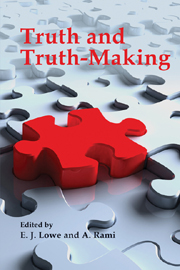Book contents
- Frontmatter
- Contents
- Preface
- Contributors
- 1 Introduction: truth and truth-making
- Part I Setting the stage
- Part II The current debate
- 8 Truth-making and correspondence
- 9 Facts and relations: the matter of ontology and of truth-making
- 10 Being and truth
- 11 An essentialist approach to truth-making
- 12 Are there irreducibly relational facts?
- 13 Why truth-makers
- 14 Postscript to “Why truth-makers”
- Bibliography
- Index
8 - Truth-making and correspondence
from Part II - The current debate
- Frontmatter
- Contents
- Preface
- Contributors
- 1 Introduction: truth and truth-making
- Part I Setting the stage
- Part II The current debate
- 8 Truth-making and correspondence
- 9 Facts and relations: the matter of ontology and of truth-making
- 10 Being and truth
- 11 An essentialist approach to truth-making
- 12 Are there irreducibly relational facts?
- 13 Why truth-makers
- 14 Postscript to “Why truth-makers”
- Bibliography
- Index
Summary
The truth-maker principle says that for every truth there is something that makes it true, that every truth has a truth-maker. A correspondence theory of truth aims to account for truth in terms of correspondence with reality, or rather with appropriate chunks of reality, typically said to be facts. One feels that there is a natural kinship between the two. D. M. Armstrong puts it like this: “Anybody who is attracted to the Correspondence theory of truth should be drawn to the truthmaker. Correspondence demands a correspondent, and a correspondent for a truth is a truthmaker” (Armstrong 1997: 14).
On the other hand, it is only kinship. Armstrong also maintains (ibid.: ch. 8.5) that the correspondence theory is too ambitious in certain crucial respects and that the truth-maker principle improves on it by being more modest while at the same time capturing what is right about the correspondence theory. Michael Dummett, rather less sympathetic to the correspondence theory, had said earlier that “we have nowadays abandoned the correspondence theory of truth”; but he added that it nevertheless “expresses one important feature of the concept of truth…: that a statement is true only if there is something in the world in virtue of which it is true” (Dummett 1959: 14). Alex Oliver has put this more starkly: “The truth-maker principle is a sanitised version of a correspondence theory of truth” (Oliver 1996: 69).
- Type
- Chapter
- Information
- Truth and Truth-Making , pp. 137 - 157Publisher: Acumen PublishingPrint publication year: 2008
- 5
- Cited by



